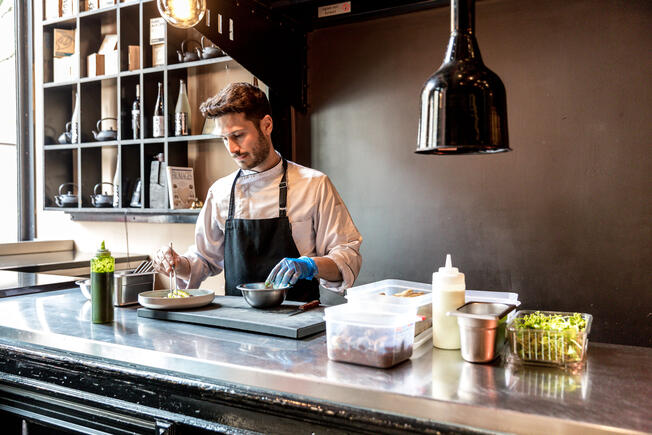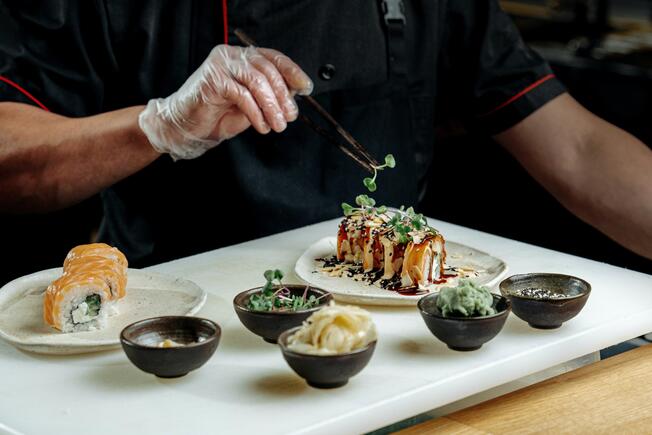How to ensure that all food is safe to eat

What are the basics of food safety?
Food safety refers to the appropriate practices which must be respected when it comes to preparing, handling, storing and serving food to prevent foodborne illness. Ensuring food safety is a critical issue for restaurants: failure to respect food safety guidelines for restaurants can be potentially disastrous resulting in sick customers, long-term damage to your reputation, and even being shut down by your local food safety inspection authorities.
Fortunately food safety principles are actually fairly straightforward and easy to implement. So keep both your customers and your reputation safe by following these basic food safety and hygiene principles and guidelines.
What are the four basic food safety principles?
All of your restaurant employees should know the four basic food safety principles to prevent food-borne illness. We recommend posting them in a highly visible spot in the kitchen as a daily reminder.
CLEAN
- Ensure that all employees wash their hands with warm water and soap for at least 20 seconds before and after handling food and after using the bathroom. Note: always make sure that there is an ample supply of hand soap in every restroom and in the kitchen. Nothing makes a worse impression on customers than an empty soap dispenser in the restroom.
- Wash and sanitize all cooking utensils, dishes, cutting boards and countertops thoroughly.
- Don’t forget to always clean and sanitize all storage areas, trash cans and floors.
- Wash all fruit and vegetables with running water and scrub hard vegetables.
- Clean all lids of canned goods before opening.
- Prevent pests (mice, cockroaches, rats, flies…) by always keeping food covered in closed containers. Make sure rubbish bins are always covered and remove rubbish regularly.
SEPARATE
- Always separate all raw meat, poultry, seafood, and eggs from other foods
- Use separate cutting boards for fresh produce and raw meat, poultry and seafood. Try using color-coded cutting boards and storage containers to help staff keep track.
- Never place cooked food on a plate that was used to hold raw meat, poultry, seafood or eggs. Thoroughly wash any plate or cutting board used for raw meat, poultry, seafood or eggs.
- Marinades used on raw foods should only be reused if they have been first brought to a boil.
COOK
- Always cook food to the right temperature. According to the WHO*, food must reach a temperature of 70 degrees Celsius to ensure it is safe to eat. Using a food thermometer is the safest way to ensure the safety of meat, poultry, seafood, and egg products for all cooking methods. These foods must be cooked to a safe minimum internal temperature to destroy any harmful bacteria.
- Always make sure food is reheated to the temperature required to eliminate possible pathogens
- Make sure food is cooled properly before being placed in cold storage.
- Ensure proper room temperatures and ventilation are maintained in all food preparation areas. Vapors and fumes must be vented outside. Use only restaurant-approved kitchen hoods and provide the proper amount of exhaust recycling.
CHILL
Foods should always be refrigerated promptly and at the right temperature.
- Use only restaurant-approved refrigerators and freezers. Be sure the refrigerator temperature is consistently 40° F or below and the freezer temperature is 0° F or below.
- Refrigerate or freeze meat, poultry, eggs, seafood, and other perishable products within 2 hours of cooking or purchasing. Refrigerate within 1 hour if the temperature outside is above 90° F.
- Never defrost food at room temperature, such as on the counter top.
- Defrost food safely: in the refrigerator, in cold water, or in the microwave. Food thawed in cold water or in the microwave should be cooked immediately.
- Always marinate food in the refrigerator.
Make sure that you provide regular food safety training for both new hires and seasoned employees.
How to set up a food safety management system for your restaurant
👩🏫 Educate and train your restaurant staff on how to safely prepare and serve food. Food safety topics to discuss: personal hygiene, proper cooking practices, protection from cross contamination, proper holding practices, cleaning methods, prevention of pests, using approved supplier sources…
🔎 Take your own food safety risk assessment: Identify food safety and hygiene risk potential processes and areas. Set up a food safety risk monitoring system.
🏷️ Make sure that you have a food traceability system in place. You should always be able to provide information about where food comes from and when it was purchased. Check expiration dates on food on a daily basis. Do not use food beyond its expiry date.
🤝🏻 Work with suppliers who demonstrate that they have a food safety system in place and that they respect it; check all food shipments carefully to ensure that proper temperature and storage conditions have been observed.
🙋Create a food safety team or representative to keep everyone on board.
🧐 Organize a third-party food safety audit once a year to see if you need to improve.
📰 Find out about the latest developments in food safety. There are many international organizations that provide information about food safety issues. Here are a few resources:
International Association of Food Protection, the Conference for Food Protection, the Global Food Safety Initiative, the European Food Safety Authority.
Keep in mind that as a restaurant owner preventing food-borne illness should always be top of mind. Your employees should all understand the importance of respecting food safety principles to protect the health of your customers and the long-term sustainability and reputation of your business.









